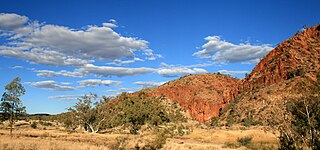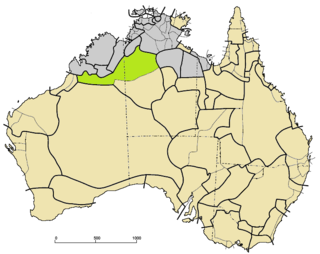Cultural practices and beliefs
In order to manufacture a gum for use in fixing tufts of flax to the bodies of dancers in their corroborees, the Bilingara used to call on one of the clan who would not be participating in the dance itself. Once handed a piece of string woven from human hair, the person who was to supply his blood used it as a ligature of his biceps, and then cut into an artery with a stone, jabbing away until an ample flow was secured, which was caught in a bark basin at his feet. What was not used for making gum was given to dingos to lap up.
Their native pharmacopeia drew on things like lemon grass (gubuwubu) and Dodonaea polyzyga (yirrigaji) for preparing a medicinal drink or lotion, mixed with a slurry of termite mound earth (mardumardu) to treat congestion, for example.
With regard to conception, the Bilinarra consider that children pre-exist their actual births, in the form of spirits that linger around an outcrop of rocks at a site called Gurdurdularni ('the place of women's children). Even the spirits of the dead (yirrmarug) may reincarnate themselves by shifting into the foetus of a pregnant woman. Numerous foods were taboo for such women, the bans being related to beliefs that such meats might damage the unborn child. Turtle (gurwarlambara) meat for example was forbidden because it was thought that, were it consumed, the child would grow up walking with a turtle-like waddle.
History of contact
The first non-Aboriginal (gardiya), that is, European, to venture into the Victoria Downs area was John Lort Stokes in 1839. The first major exploratory expedition followed in 1855-1856 when the area was surveyed by Francis Gregory and his brother Henry, and they reported favourably on its prospects for pastoral development. In 1883 Charles Fisher and Maurice Lyons set up the Victoria River Downs Station on an area that extended over Bilingara and Karrangpurru lands.
The Bilinarra suffered from massacres during the period of their dispossession as their land was taken over for pastoral development, and even thereafter, on the stations where they sought employment, were treated harshly. Like other tribes in the area, they suffered from the standard three successive waves of colonial devastation: introduced disease, land-clearing massacres, [lower-alpha 1] and forced labour on the new pastoral leases. Meakins and Nordlinger state that with the establishment in 1894 of a police station run by Willshire "massacres became the officially sanctioned method of population control." Their numbers rapidly declined.
In Bilinarra oral history accounts, two massacres in particular are recorded for this early period. One group of tribesmen were rounded up and brought into the Gordon Creek police station, where they were tethered and then shot, with their bodies then burnt and dumped into a rubbish tip for cattle bones. In a further incident, a cook prepared a stew for some Bilinarra, lacing it with strychnine. Thereafter the site was named Poison Creek. Survivors eventually made their way into Ngarinman territory, where many were killed as intruders, while women were taken as wives. Those women returned to Bilinarra lands on the demise of their husbands.
Some time around 1922 a Bilinarra youth nicknamed "Banjo" killed the Billiluna station manager Condon and his white stockman, Sullivan, after the latter had abducted his woman for sexual purposes. Banjo remonstrated with the usurper, but to no effect, other than being dressed down. When the time came for the annual calf-branding, Banjo snuck into the station and, seizing a rifle on a table, shot Sullivan in the thigh, and he died of the wound soon after. He then aimed at Condon, who asked him not to shoot, and killed him. The other blacks thought of spearing him, but he had the upper hand with a rifle, and ordered some of them to report the murder to the manager of another station, while he slipped off to the Kimberley with his girl. Jack Flinders eventually tracked him down near Mary River and Louisa Downs, and shot him dead.
Bilinarra people joined Gurindji and other workers in the Wave Hill walk-off in 1967, to protest poor working conditions on the cattle station. [20]
The Wave Hill walk-off, also known as the Gurindji strike, was a walk-off and strike by 200 Gurindji stockmen, house servants and their families, starting on 23 August 1966 and lasting for seven years. It took place at Wave Hill, a cattle station in Kalkarindji, Northern Territory, Australia, and was led by Gurindji man Vincent Lingiari.
The Gurindji are an Aboriginal Australian people of northern Australia, 460 kilometres (290 mi) southwest of Katherine in the Northern Territory's Victoria River region.
Gurindji Kriol is a mixed language which is spoken by Gurindji people in the Victoria River District of the Northern Territory (Australia). It is mostly spoken at Kalkaringi and Daguragu which are Aboriginal communities located on the traditional lands of the Gurindji. Related mixed varieties are spoken to the north by Ngarinyman and Bilinarra people at Yarralin and Pigeon Hole. These varieties are similar to Gurindji Kriol, but draw on Ngarinyman and Bilinarra which are closely related to Gurindji.
Gurindji is a Pama–Nyungan language spoken by the Gurindji and Ngarinyman people in the Northern Territory, Australia. The language of the Gurindji is highly endangered, with about 592 speakers remaining and only 175 of those speakers fully understanding the language. There are in addition about 60 speakers of Ngarinyman dialect. Gurindji Kriol is a mixed language that derives from the Gurindji language.

Mudburra, also spelt Mudbura, Mudbarra and other variants, and also known as Pinkangama, is an Aboriginal language of Australia.

Ngumbin languages are a small language family of Australia, consisting of :
Victoria River Downs Station, also known as Victoria Downs and in the past sometimes referred to as The Big Run, is a pastoral lease that operates as a cattle station in the Northern Territory of Australia, established in 1883.
Bilingara, also known as the Bilinarra, is an Australian Aboriginal language spoken by the Bilinarra people of the Northern Territory.
Yarralin, also known as Walangeri, is a remote Aboriginal community in the Northern Territory of Australia. At the 2016 census, Yarralin had a population of 293. The community is located on the banks of the Wickham River, about 15 km (9 mi) west of Victoria River Downs, a major cattle station along the Buchanan Highway.
Felicity Meakins is a linguist specialising in Australian Indigenous languages, morphology and language contact, who was one of the first academics to describe Gurindji Kriol. As of 2022, she is a professor at the University of Queensland and Deputy Director of the University of Queensland node of the Australian Research Council (ARC) Centre of Excellence for the Dynamics of Language. She holds an ARC Future Fellowship focusing on language evolution and contact processes across northern Australia.
The Ngarinman or Ngarinyman people are an Aboriginal Australian people of the Northern Territory who spoke the Ngarinyman language.
The Djaru people are an Aboriginal Australian people of the southern Kimberley region of Western Australia.
The Malngin are an Aboriginal Australian people of the Kimberley region of Western Australia. The Malngin language was a dialect of Gurindj.

The Luritja or Loritja people, also known as Kukatja or Kukatja-Luritja, are an Aboriginal Australian people of the Northern Territory. Their traditional lands are immediately west of the Derwent River, that forms a frontier with the Arrernte people, with their lands covering some 27,000 square kilometres (10,300 sq mi). Their language is the Luritja dialect, a Western Desert language.
The Gudanji, otherwise known as the Kotandji or Ngandji, are an indigenous Australian people of the Northern Territory.
The Warlmanpa are an indigenous Australian people of the Northern Territory.
The Mudburra, also spelt Mudbara and other variants, are an Aboriginal Australian people of the Northern Territory.
The Karrangpurru are an Aboriginal Australian people of the Northern Territory. They suffered severe population loss very early on in the period of colonial expropriations of their land.
The Wandjira were an indigenous Australian people of the Northern Territory.

Owen Stephen Cummins was a stockman, drover and horse breeder who is thought to be one of the possible inspirations for the poem A Man from Snowy River by Andrew Barton "Banjo" Paterson.
This page is based on this
Wikipedia article Text is available under the
CC BY-SA 4.0 license; additional terms may apply.
Images, videos and audio are available under their respective licenses.



